Analysis of the Viability of a Photovoltaic Greenhouse with Semi-Transparent Amorphous Silicon (a-Si) Glass
Abstract
:1. Introduction
2. Materials and Methods
2.1. Prototype Description
- Temperature, relative humidity and CO2 sensor.
- PAR radiation sensor.
- Fan to ventilate/extract.
- Heater for warming up with a power of 1800 W.
- 2-nozzle telescopic nebulizer.
- Drip irrigation system.
- Network analyzer for energy consumption analysis.
- Power: power module made up of power supplies and transformers, responsible for feeding all the components of the system.
- Sensors: room sensorization module.
- Data concentrator: information storage module.
- Wireless gateway: wireless communication module for receiving data from wireless sensors.
- PLC: control module.
- Actuators: module made up of the actuators or control elements of the system.
- Protection against electrical overloads.
- The system’s power supplies.
- The power supply transformers of the solenoid valves.
- Network analyzers.
- The communication gateway with the wireless sensors.
- Contactors to control the loads of the control system of both greenhouses.
- Connectors for sensors.
- Connectors for the actuators.
2.2. Type of Crop
3. Results
3.1. Monitoring Before Planting
3.2. Monitoring After Planting
3.3. Horticultural Production
3.4. Net Energy Balance
4. Discussion
5. Conclusions
Author Contributions
Funding
Institutional Review Board Statement
Informed Consent Statement
Data Availability Statement
Acknowledgments
Conflicts of Interest
Abbreviations
| a-Si | amorphous silicon. |
| BIPV | building-integrated photovoltaic technology. |
| CO2 ext | outdoor CO2 concentration. |
| CO2 int | indoor CO2 concentration. |
| CO2 min. | minimum CO2 concentration. |
| DC | direct current. |
| DG | distributed generation. |
| FTP | file transfer protocol. |
| Hext | outdoor air humidity. |
| Hint | indoor air humidity. |
| Hmax | maximum air humidity. |
| Hmin | minimum air humidity. |
| MPPT | maximum power point tracker. |
| PAR | photosynthetically active radiation. |
| PLC | programmable logic controller. |
| PV | photovoltaic. |
| PVR | ratio of horizontal surface covered by solar panels placed on the roof. |
| SCADA | supervisory control and data acquisition. |
| Text | outdoor temperature. |
| Tint | indoor temperature. |
| Tmax | maximum temperature. |
| Tmin | minimum temperature. |
| UVa | University of Valladolid. |
References
- Aryanpur, V.; Atabaki, M.S.; Marzband, M.; Siano, P.; Ghayoumi, K. An overview of energy planning in Iran and transition pathways towards sustainable electricity supply sector. Renew. Sustain. Energy Rev. 2019, 112, 58–74. [Google Scholar] [CrossRef]
- Locker, C.R.; Torkamani, S.; Laurenzi, I.J.; Jin, V.L.; Schmer, M.R.; Karlen, D.L. Field-to-farm gate greenhouse gas emissions from corn stover production in the Midwestern U.S. J. Clean. Prod. 2019, 226, 1116–1127. [Google Scholar] [CrossRef] [Green Version]
- WBCSD. Energy Efficiency in Buildings Transforming the Market; WBCSD: Washington, DC, USA, 2009; ISBN 978-3-940388-44-5. [Google Scholar]
- Lu, Y.; Zhang, X.P.; Huang, Z.; Lu, J.; Wang, D. Impact of introducing penalty-cost on optimal design of renewable energy systems for net zero energy buildings. Appl. Energy 2019, 235, 106–116. [Google Scholar] [CrossRef]
- Hernández-Callejo, L.; Gallardo-Saavedra, S.; Alonso-Gómez, V. A review of photovoltaic systems: Design, operation and maintenance. Sol. Energy 2019, 188, 426–440. [Google Scholar] [CrossRef]
- Foster, R.; Cota, A. Solar water pumping advances and comparative economics. Energy Procedia 2014, 57, 1431–1436. [Google Scholar] [CrossRef] [Green Version]
- Chang, R.; Cao, Y.; Lu, Y.; Shabunko, V. Should BIPV technologies be empowered by innovation policy mix to facilitate energy transitions?-Revealing stakeholders’ different perspectives using Q methodology. Energy Policy 2019, 129, 307–318. [Google Scholar] [CrossRef]
- Bot, G.; Van De Braak, N.; Challa, H.; Hemming, S.; Rieswijk, T.; Straten, G.V.; Verlodt, I. The solar greenhouse: State of the art in energy saving and sustainable energy supply. In Acta Horticulturae: International Society for Horticultural Science; International Society for Horticultural Science: Leuven, Belgium, 2005; Volume 691, pp. 501–508. [Google Scholar]
- Hassanien, R.H.E.; Li, M.; Lin, W.D. Advanced applications of solar energy in agricultural greenhouses. Renew. Sustain. Energy Rev. 2016, 54, 989–1001. [Google Scholar] [CrossRef]
- Harjunowibowo, D.; Ding, Y.; Omer, S.; Riffat, S. Recent active technologies of greenhouse systems—A comprehensive review. Bulg. J. Agric. Sci. 2018, 24, 158–170. [Google Scholar]
- Yano, A.; Furue, A.; Kadowaki, M.; Tanaka, T.; Hiraki, E.; Miyamoto, M.; Ishizu, F.; Noda, S. Electrical energy generated by photovoltaic modules mounted inside the roof of a north-south oriented greenhouse. Biosyst. Eng. 2009, 103, 228–238. [Google Scholar] [CrossRef]
- Yano, A.; Kadowaki, M.; Furue, A.; Tamaki, N.; Tanaka, T.; Hiraki, E.; Kato, Y.; Ishizu, F.; Noda, S. Shading and electrical features of a photovoltaic array mounted inside the roof of an east-west oriented greenhouse. Biosyst. Eng. 2010, 106, 367–377. [Google Scholar] [CrossRef]
- Kadowaki, M.; Yano, A.; Ishizu, F.; Tanaka, T.; Noda, S. Effects of greenhouse photovoltaic array shading on Welsh onion growth. Biosyst. Eng. 2012, 111, 290–297. [Google Scholar] [CrossRef]
- Castellano, S. Photovoltaic greenhouses: Evaluation of shading effect and its influence on agricultural performances. J. Agric. Eng. 2014, 45, 168–175. [Google Scholar] [CrossRef]
- Cossu, M.; Murgia, L.; Ledda, L.; Deligios, P.A.; Sirigu, A.; Chessa, F.; Pazzona, A. Solar radiation distribution inside a greenhouse with south-oriented photovoltaic roofs and effects on crop productivity. Appl. Energy 2014, 133, 89–100. [Google Scholar] [CrossRef]
- Cossu, M.; Cossu, A.; Deligios, P.A.; Ledda, L.; Li, Z.; Fatnassi, H.; Poncet, C.; Yano, A. Assessment and comparison of the solar radiation distribution inside the main commercial photovoltaic greenhouse types in Europe. Renew. Sustain. Energy Rev. 2018, 94, 822–834. [Google Scholar] [CrossRef]
- Cossu, M.; Yano, A.; Solinas, S.; Deligios, P.A.; Tiloca, M.T.; Cossu, A.; Ledda, L. Agricultural sustainability estimation of the European photovoltaic greenhouses. Eur. J. Agron. 2020, 118, 126074. [Google Scholar] [CrossRef]
- Yano, A.; Onoe, M.; Nakata, J. Prototype semi-transparent photovoltaic modules for greenhouse roof applications. Biosyst. Eng. 2014, 122, 62–73. [Google Scholar] [CrossRef] [Green Version]
- Cossu, M.; Yano, A.; Li, Z.; Onoe, M.; Nakamura, H.; Matsumoto, T.; Nakata, J. Advances on the semi-transparent modules based on micro solar cells: First integration in a greenhouse system. Appl. Energy 2016, 162, 1042–1051. [Google Scholar] [CrossRef] [Green Version]
- Subhani, W.S.; Wang, K.; Du, M.; Wang, X.; Yuan, N.; Ding, J.; Liu, S.F. Anti-solvent engineering for efficient semitransparent CH3NH3PbBr3 perovskite solar cells for greenhouse applications. J. Energy Chem. 2019, 34, 12–19. [Google Scholar] [CrossRef] [Green Version]
- Gupta, N.; Tiwari, A.; Tiwari, G.N. A thermal model of hybrid cooling systems for building integrated semitransparent photovoltaic thermal system. Sol. Energy 2017, 153, 486–498. [Google Scholar] [CrossRef]
- Zisis, C.; Pechlivani, E.M.; Tsimikli, S.; Mekeridis, E.; Laskarakis, A.; Logothetidis, S. Organic photovoltaics on greenhouse rooftops: Effects on plant growth. In Materials Today: Proceedings; Elsevier Ltd.: Amsterdam, The Netherlands, 2020; Volume 21, pp. 65–72. [Google Scholar]
- Song, W.; Fanady, B.; Peng, R.; Hong, L.; Wu, L.; Zhang, W.; Yan, T.; Wu, T.; Chen, S.; Ge, Z. Foldable Semitransparent Organic Solar Cells for Photovoltaic and Photosynthesis. Adv. Energy Mater. 2020, 10. [Google Scholar] [CrossRef]
- Emmott, C.J.M.; Röhr, J.A.; Campoy-Quiles, M.; Kirchartz, T.; Urbina, A.; Ekins-Daukes, N.J.; Nelson, J. Organic photovoltaic greenhouses: A unique application for semi-transparent PV? Energy Environ. Sci. 2015, 8, 1317–1328. [Google Scholar] [CrossRef]
- Marucci, A.; Cappuccini, A. Dynamic photovoltaic greenhouse: Energy efficiency in clear sky conditions. Appl. Energy 2016, 170, 362–376. [Google Scholar] [CrossRef]
- Li, Z.; Yano, A.; Cossu, M.; Yoshioka, H.; Kita, I.; Ibaraki, Y. Electrical Energy Producing Greenhouse Shading System with a Semi-Transparent Photovoltaic Blind Based on Micro-Spherical Solar Cells. Energies 2018, 11, 1681. [Google Scholar] [CrossRef] [Green Version]
- Moretti, S.; Marucci, A. A photovoltaic greenhouse with variable shading for the optimization of agricultural and energy production. Energies 2019, 12, 2589. [Google Scholar] [CrossRef] [Green Version]
- Aira, J.R. Aprovechamiento y Valorización de la Madera. In Parques Naturales y Espacios Naturales Protegidos, La Gestión del Parque Natural de la Serranía de Cuenca; Universidad de Castilla-La Mancha: Toledo, Spain, 2016; pp. 17–56. ISBN 978-84-9044-224-1. [Google Scholar]
- Hernández-Callejo, L.; Alonso-Gómez, V.; Eugenio-Gozalbo, M.; Rico-Rodríguez, E.; Huerta-Illera, I.; del Caño-González, T. Invernadero Fotovoltaicoes. In Efficient, Sustainable, and Fully Comprehensive Smart Cities. II Ibero-American Congress of Smart Cities (ICSC-CITIES 2019); Leite, V., Callejo, L.H., Prieto, J., Cañón, C.L.Z., Ferreira, Â., Nesmachnow, S., Peña, F.C., Eds.; Editorial Universidad Santiago de Cali: Soria, Spain, 2019; pp. 434–455. [Google Scholar]
- Hassanien, R.H.E.; Li, M. Influences of greenhouse-integrated semi-transparent photovoltaics on microclimate and lettuce growth. Int. J. Agric. Biol. Eng. 2017, 10, 11–22. [Google Scholar] [CrossRef] [Green Version]
- Hassanien, R.H.E.; Li, M.; Yin, F. The integration of semi-transparent photovoltaics on greenhouse roof for energy and plant production. Renew. Energy 2018, 121, 377–388. [Google Scholar] [CrossRef]
- Ureña-Sánchez, R.; Callejón-Ferre, Á.J.; Pérez-Alonso, J.; Carreño-Ortega, Á. Greenhouse tomato production with electricity generation by roof-mounted flexible solar panels. Sci. Agric. 2012, 69, 233–239. [Google Scholar] [CrossRef]
- Shi, H.; Xia, R.; Zhang, G.; Yip, H.L.; Cao, Y. Spectral Engineering of Semitransparent Polymer Solar Cells for Greenhouse Applications. Adv. Energy Mater. 2019, 9. [Google Scholar] [CrossRef]



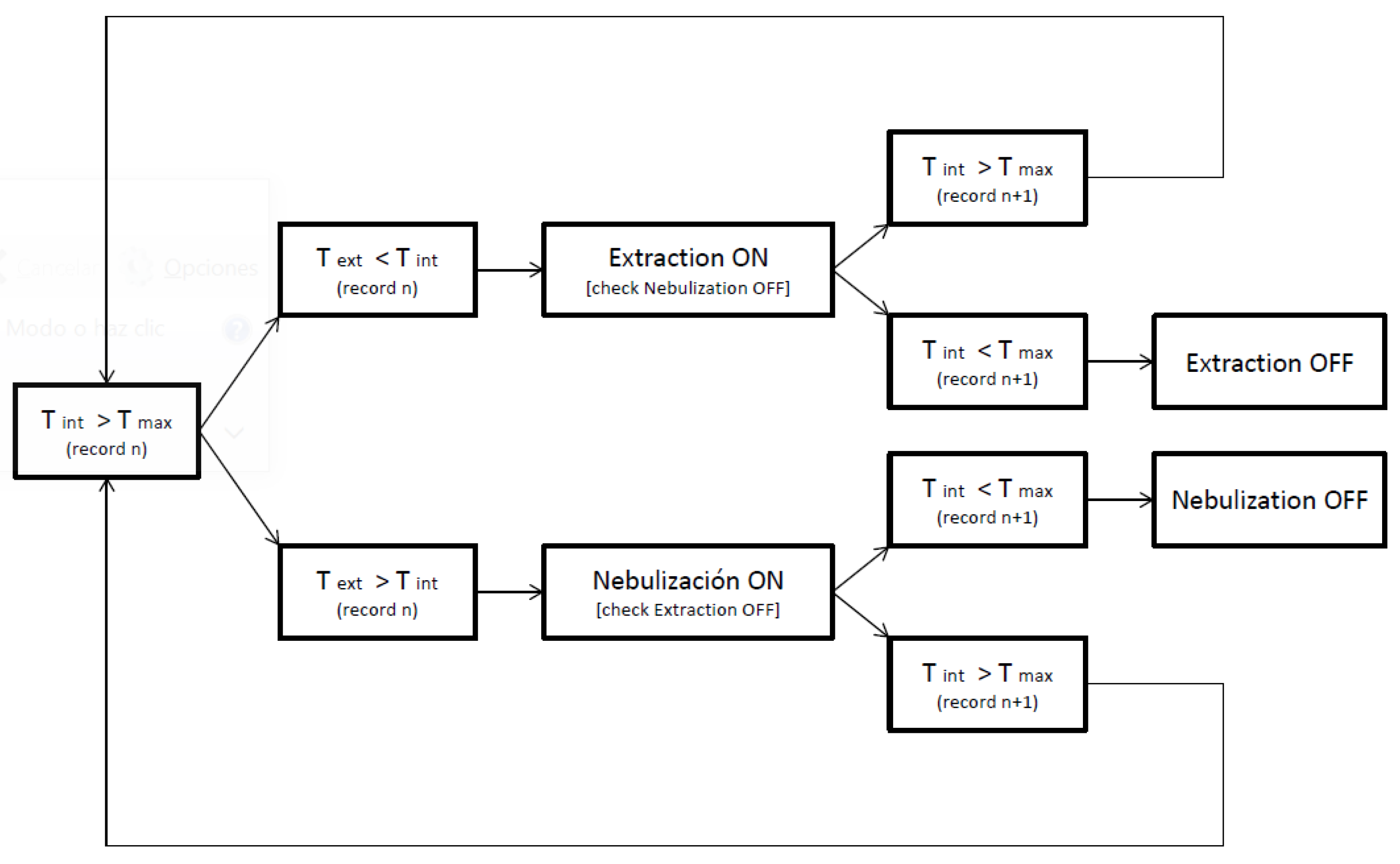




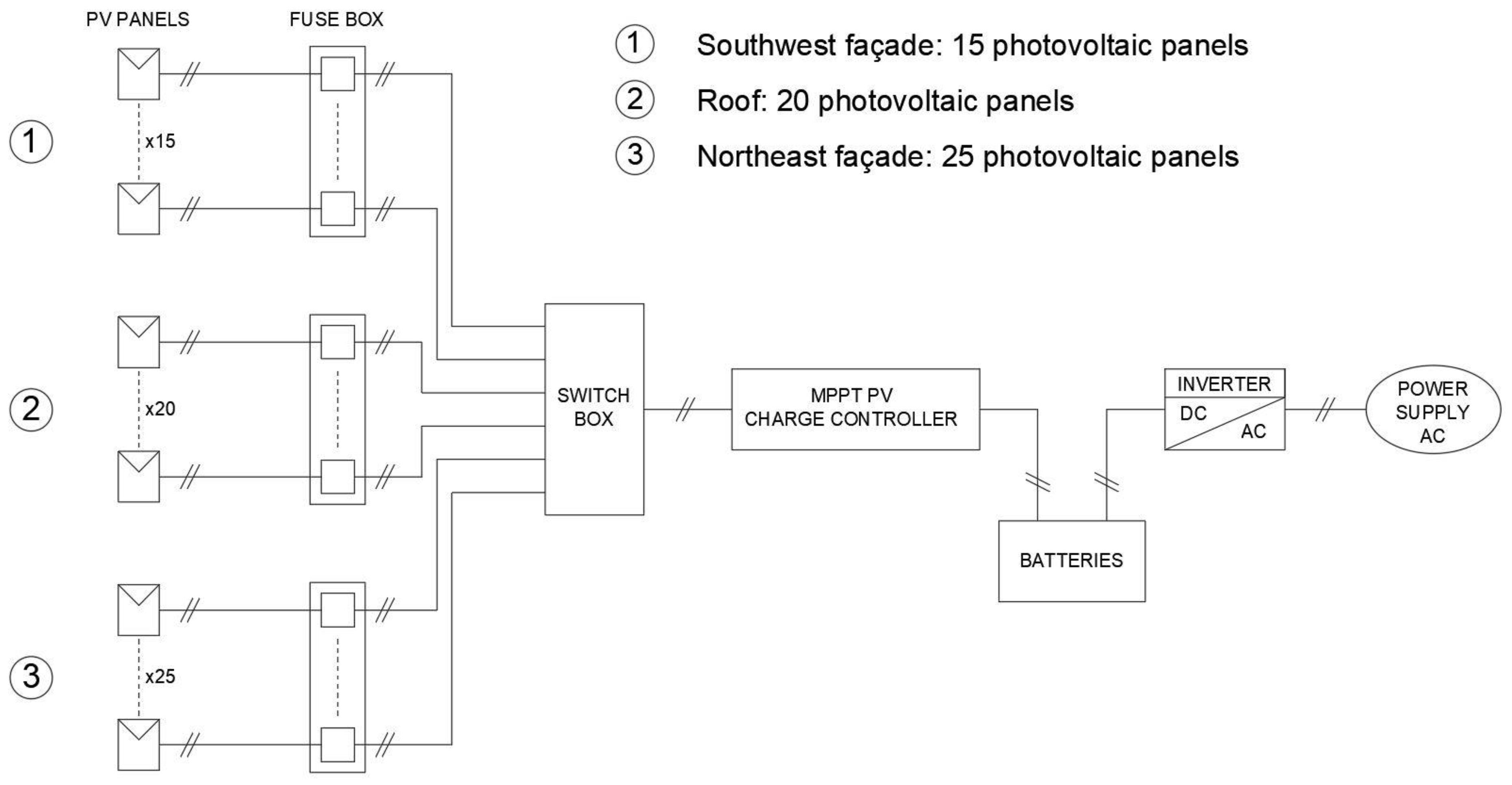


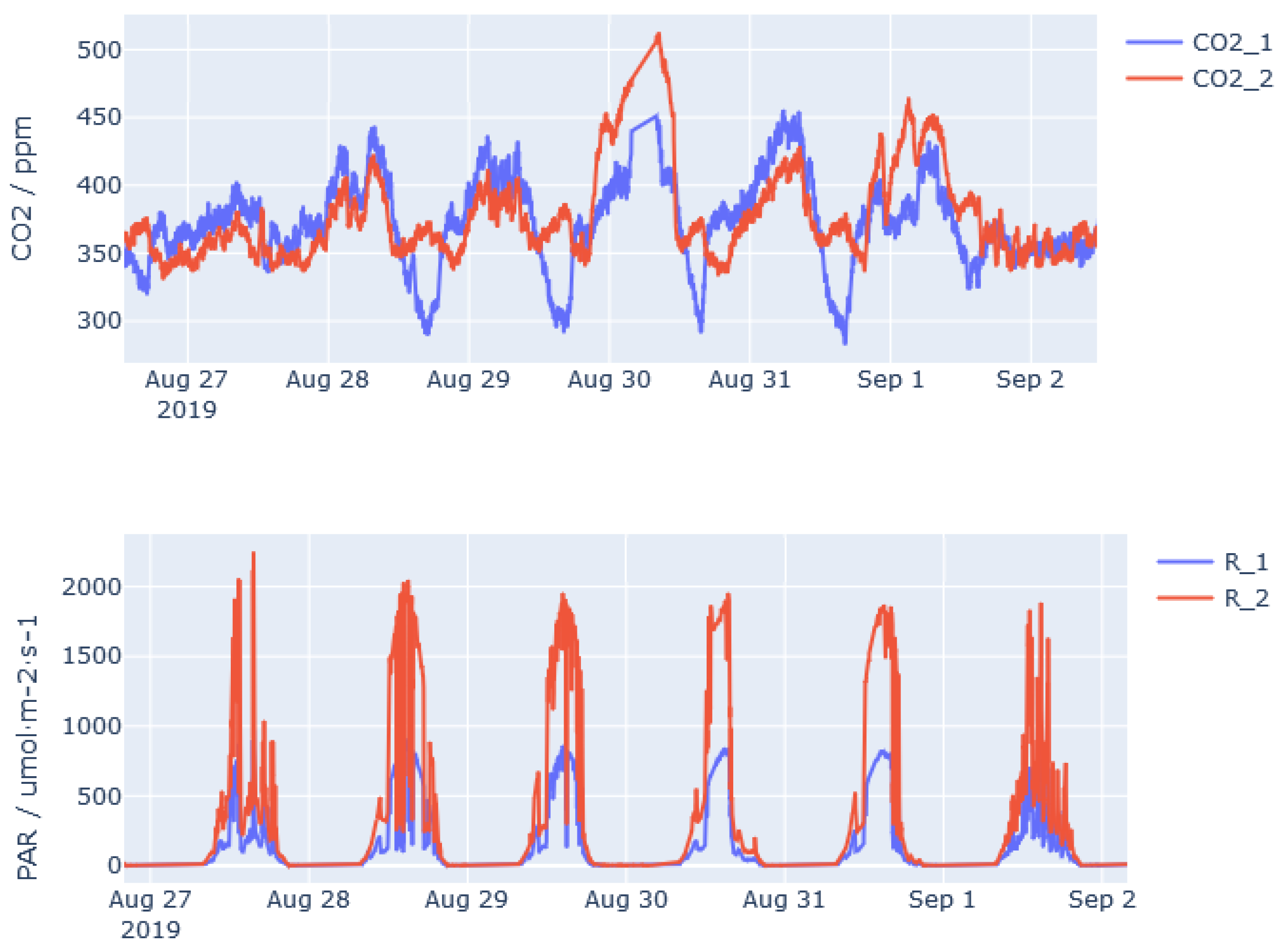
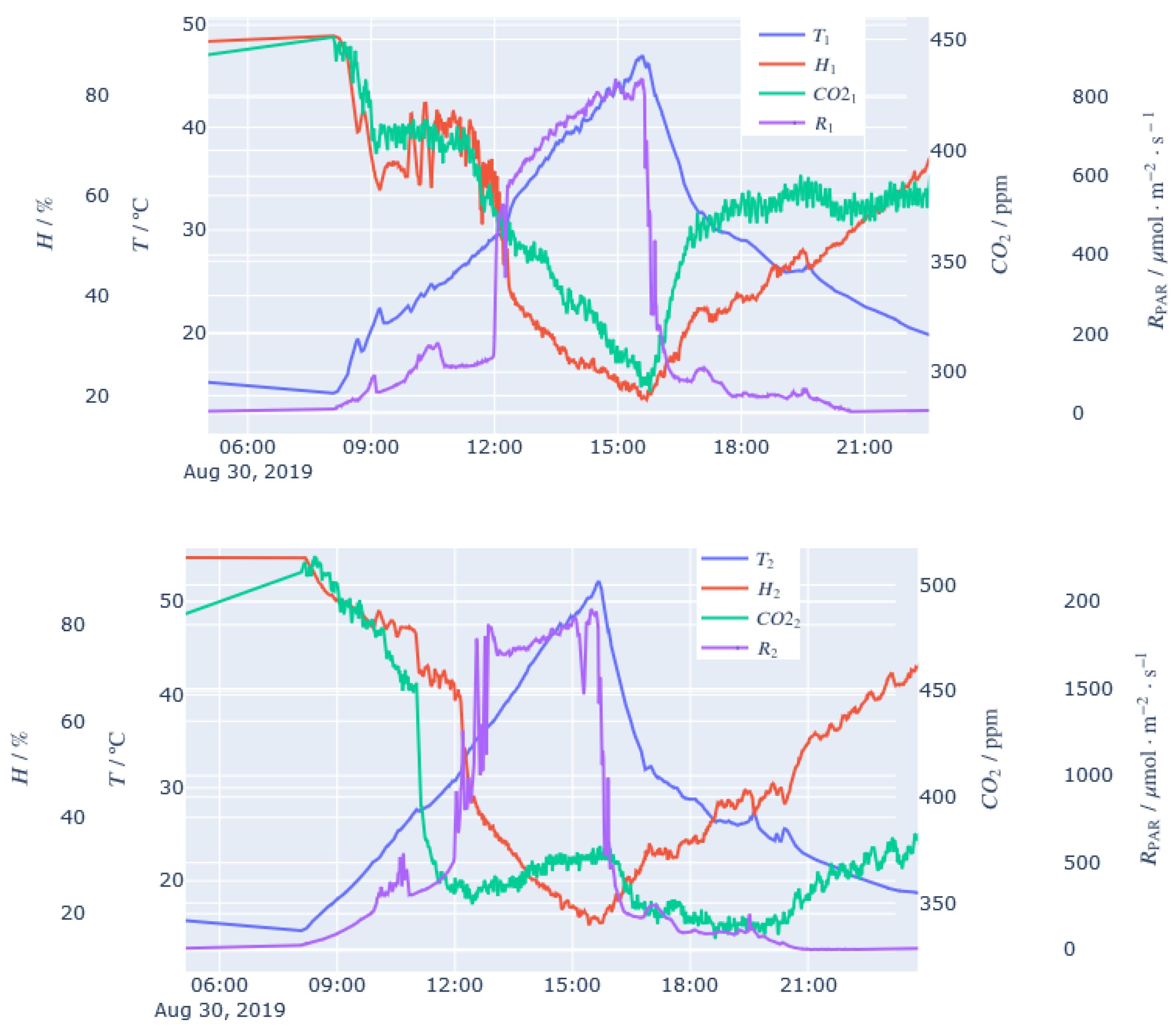
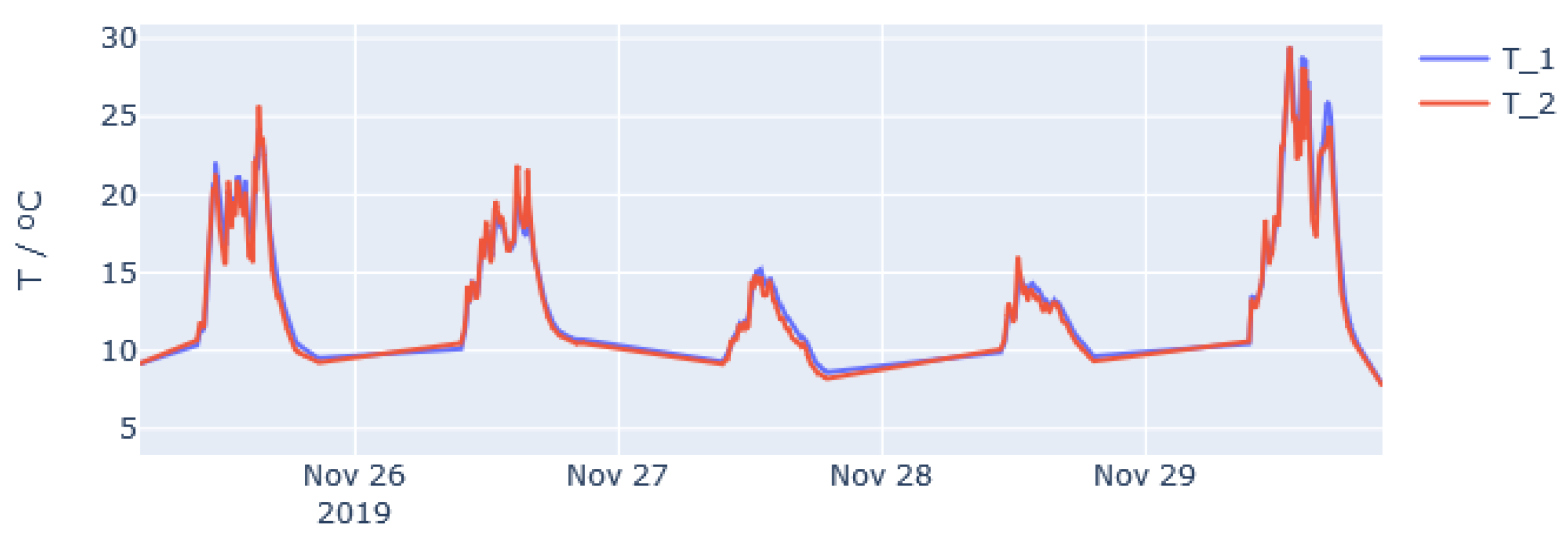
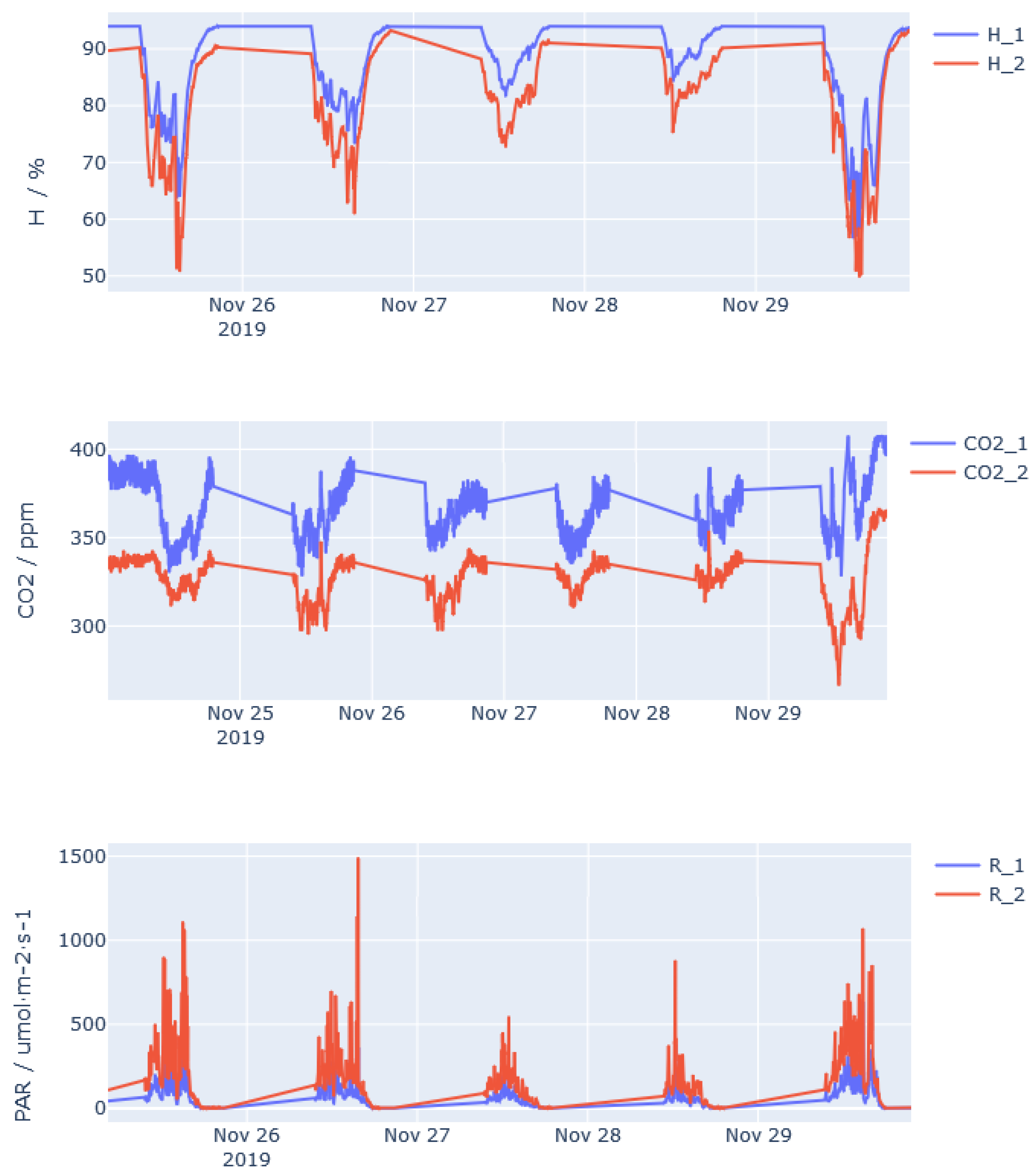
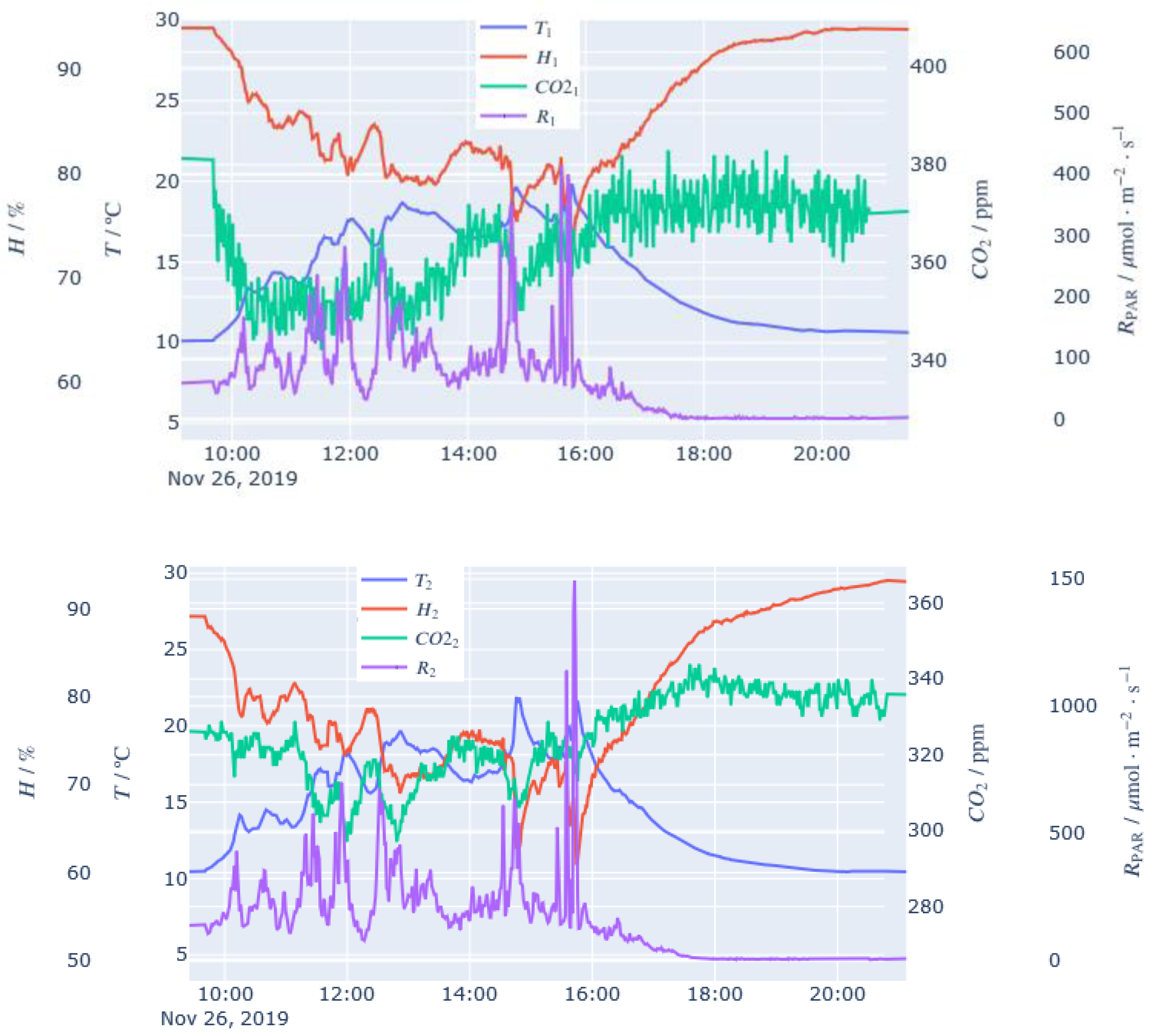
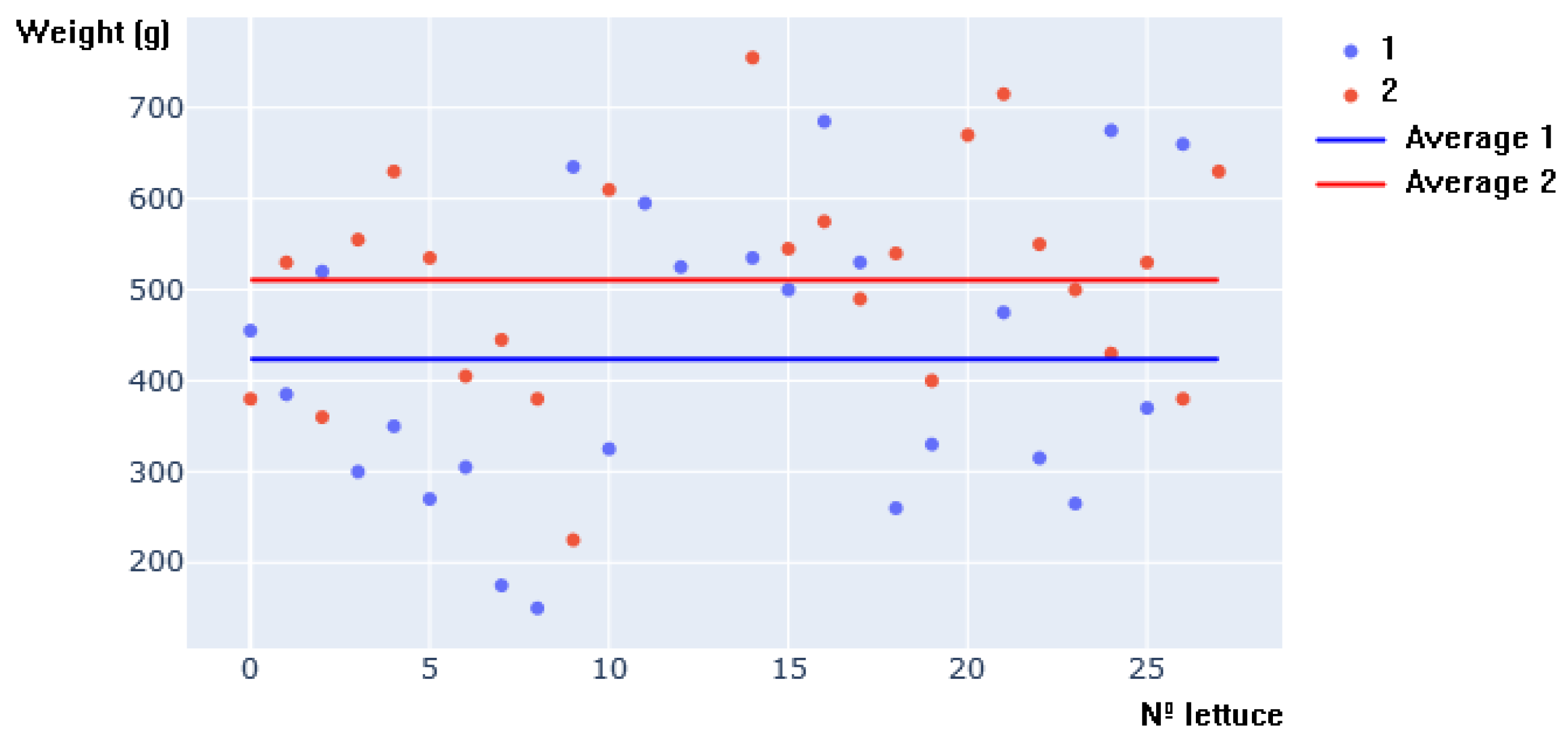
| Model | 034-BN-12450635-30-1 |
|---|---|
| Setting: | Glass-glass (without inert chamber) |
| Dimensions: | 1245 mm × 635 mm × 7.96 mm (3.2 glass + 0.76 PVB encapsulation + 4 glass) |
| Transparency: | Colorless glass with 30% transparency |
| PV technology type: | Amorphous silicon |
| Rated power: | 22 W per module//1320 W in total over the entire active area (60 modules) |
| Special treatments: | No special treatments |
| Sensor | Departure |
|---|---|
| Outside temperature, humidity and CO 2 | Modbus RTU |
| Indoor temperature, humidity and CO 2 | Modbus RTU |
| PAR radiation | 0–10 VDC |
| Network analyzer | Modbus RTU |
| Actuators | Entry |
| Extractor fan | 0–230 VAC |
| Heater | 0–230 VAC |
| Nebulizer | 0–230 VAC |
| Others | Entry |
| Drip irrigation | 0–230 VAC |
| 25 October 2019 | 06 November 2019 | 22 November 2019 | 29 November 2019 | |||||
|---|---|---|---|---|---|---|---|---|
| Average Height (cm) | CoV | Average Height (cm) | CoV | Average Height (cm) | CoV | Average Height (cm) | CoV | |
| PV glass section | 30 | 0.23 | 49 | 0.2 | 52 | 0.2 | 57 | 0.19 |
| Conventional glass section | 26 | 0.23 | 44 | 0.25 | 46 | 0.22 | 50 | 0.2 |
Publisher’s Note: MDPI stays neutral with regard to jurisdictional claims in published maps and institutional affiliations. |
© 2021 by the authors. Licensee MDPI, Basel, Switzerland. This article is an open access article distributed under the terms and conditions of the Creative Commons Attribution (CC BY) license (https://creativecommons.org/licenses/by/4.0/).
Share and Cite
Aira, J.-R.; Gallardo-Saavedra, S.; Eugenio-Gozalbo, M.; Alonso-Gómez, V.; Muñoz-García, M.-Á.; Hernández-Callejo, L. Analysis of the Viability of a Photovoltaic Greenhouse with Semi-Transparent Amorphous Silicon (a-Si) Glass. Agronomy 2021, 11, 1097. https://doi.org/10.3390/agronomy11061097
Aira J-R, Gallardo-Saavedra S, Eugenio-Gozalbo M, Alonso-Gómez V, Muñoz-García M-Á, Hernández-Callejo L. Analysis of the Viability of a Photovoltaic Greenhouse with Semi-Transparent Amorphous Silicon (a-Si) Glass. Agronomy. 2021; 11(6):1097. https://doi.org/10.3390/agronomy11061097
Chicago/Turabian StyleAira, José-Ramón, Sara Gallardo-Saavedra, Marcia Eugenio-Gozalbo, Víctor Alonso-Gómez, Miguel-Ángel Muñoz-García, and Luis Hernández-Callejo. 2021. "Analysis of the Viability of a Photovoltaic Greenhouse with Semi-Transparent Amorphous Silicon (a-Si) Glass" Agronomy 11, no. 6: 1097. https://doi.org/10.3390/agronomy11061097
APA StyleAira, J.-R., Gallardo-Saavedra, S., Eugenio-Gozalbo, M., Alonso-Gómez, V., Muñoz-García, M.-Á., & Hernández-Callejo, L. (2021). Analysis of the Viability of a Photovoltaic Greenhouse with Semi-Transparent Amorphous Silicon (a-Si) Glass. Agronomy, 11(6), 1097. https://doi.org/10.3390/agronomy11061097











